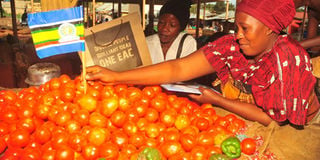Increased food supply ease September inflation to 1.4%

Traders at Nakiwogo Landing Site market in Entebbe arrange their commodities. Low food prices have led to a fall in the September inflation. PHOTO BY STEPHEN WANDERA
What you need to know:
Not affected. Other commodities remain highly priced amid stagnant wages.
Kampala. Inflation has continued on a downward trend for the seventh month in row, falling by 1.4 percentage points in September.
This has been attributed to increased food supply and subdued demand due to lag effects of a tight monetary stance.
The Consumer Price Index released by the Uganda Bureau of Statistics yesterday indicates that consumer prices eased to 1.4 per cent in September from 2.8 per cent recorded in August 2014.
Releasing figures yesterday, the director macro-economic statistics Uganda Bureau of Statistics, Mr Chris Ndatira Mukiza, said the country is yet to recover from a slowdown in aggregate demand that resulted from a tight monetary policy deployed by Bank of Uganda to tame inflationary pressure.
The tight monetary stance stifled growth in private sector credit as interest rates peaked to over 30 per cent.
This has resulted into subdued demand as the public has limited money to spend.
High interest rates saw most commercial banks post profit declines for the past two years and others writing off huge sums in bad debts as the lag effects of the turbulent economic challenges suffered in 2011 continue to bite.
On the other hand, the fall in food crop inflation, which declined to -1.9 per cent compared to a 1.5 per cent increase posted in August, according to Mr Mukiza, was due to increased food supply to markets due to fewer exports as a result of instability in South Sudan.
“Uganda is now exporting less to South Sudan meaning that most of the food is now sold in the local markets that’s why we are seeing a drop in food prices,” he said.
Similarly, core inflation – which excludes the often volatile food crops, fuel, electricity and metered water prices – declined further to 2 per cent in September from 3.1 in August.
Inflation which hit a high of 30.5 per cent in October 2011 has been on a steady decline since March this year, surpassing the Central Bank’s 5 per cent target.
Other factors
The fall in inflation would have been bigger had it not been held back by an increase in petrol, paraffin and gas prices which led to a 2.5 per cent increase in the energy, fuel and utilities index.
The drop is, however, expected to bring limited relief to households as other commodity prices, except food, remain highly priced amid stagnant wages.
Economists said the numbers suggested price pressures in the economy were benign, due to increased food supply to markets.
Figures showing Uganda’s inflation trends month by month
1.4%
The inflation rate for the month of September.
2.8%
The inflation rate for the month of August.
4.3%
The inflation rate for the month of July.
5%
The inflation rate for the month of June.
5.4%
The inflation rate for the month of May.
6.7%
The inflation rate for the month of April.
7.1%
The inflation rate for the month of March.
6.8%
The inflation rate for the month of February




